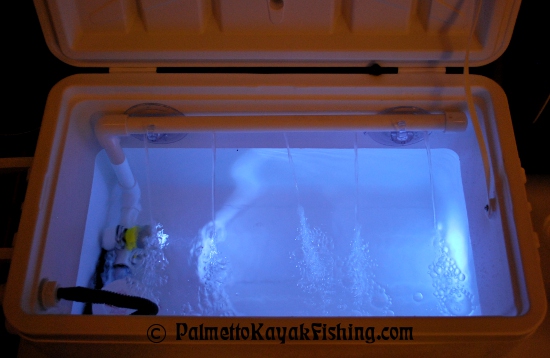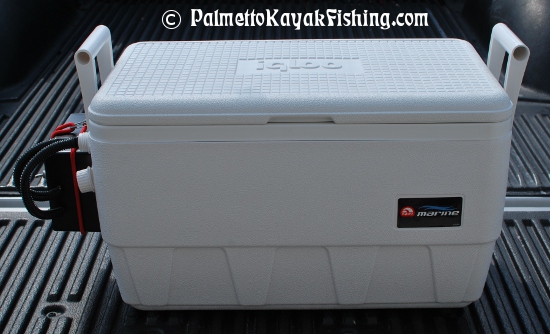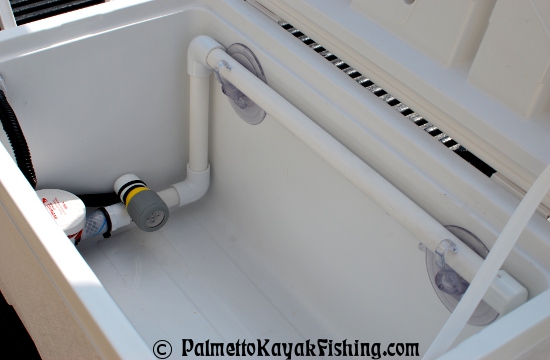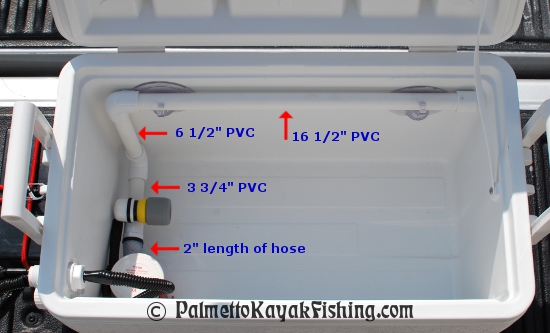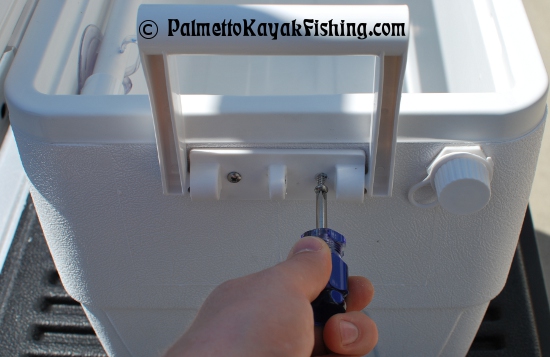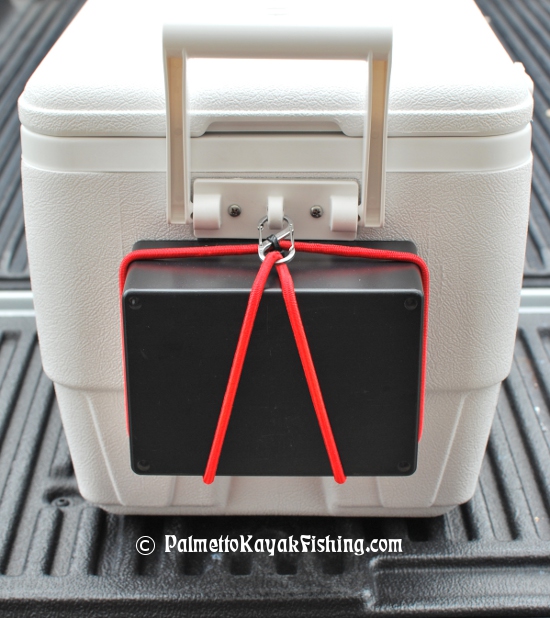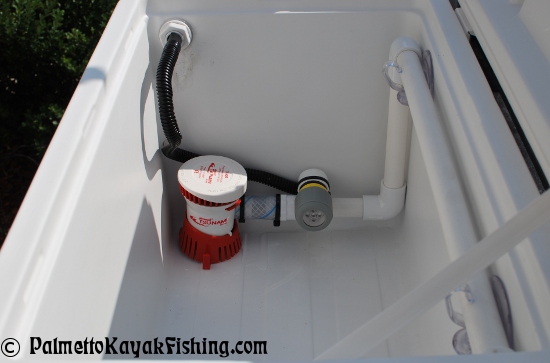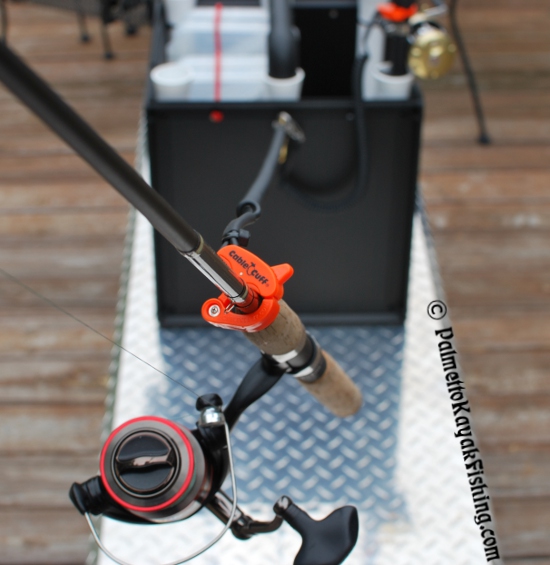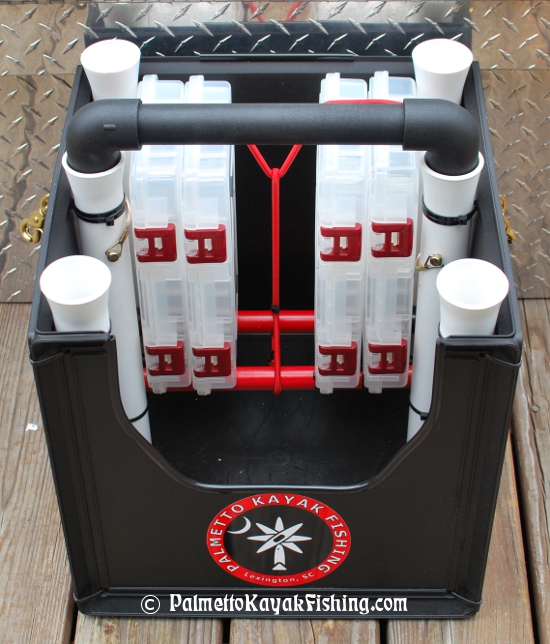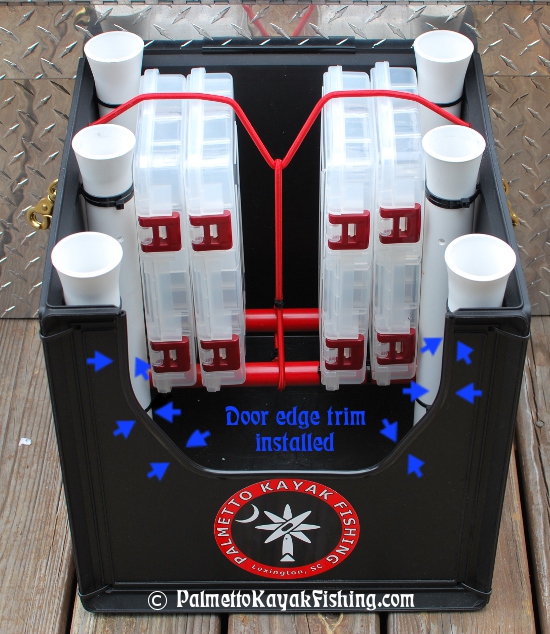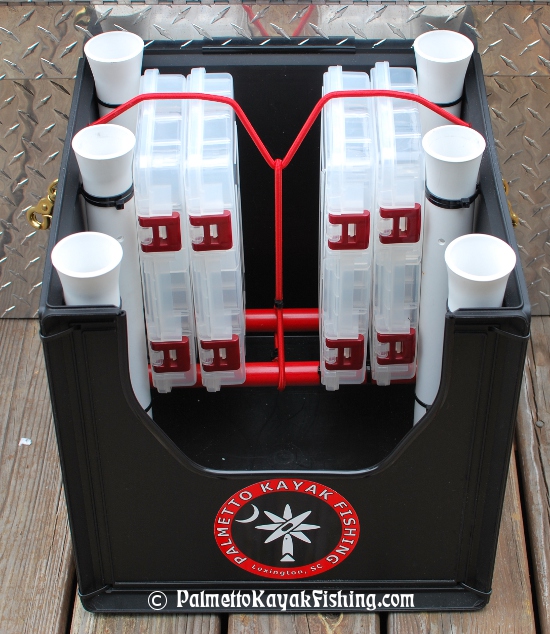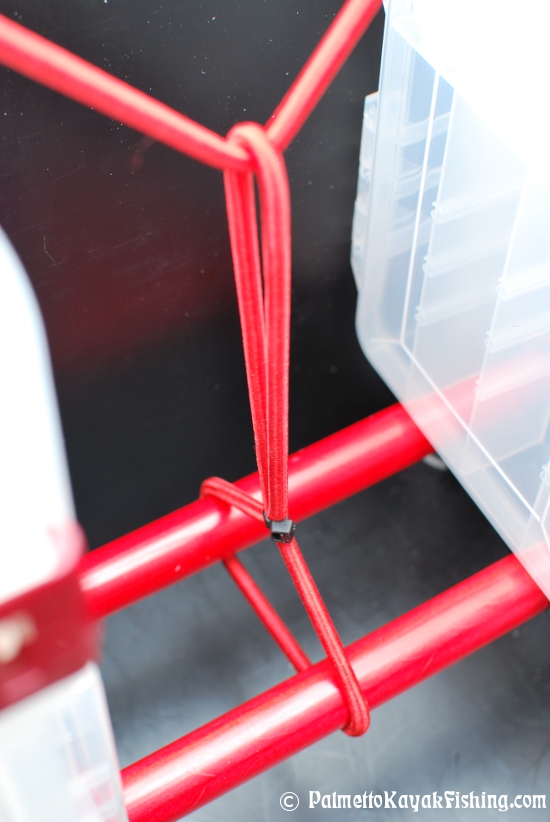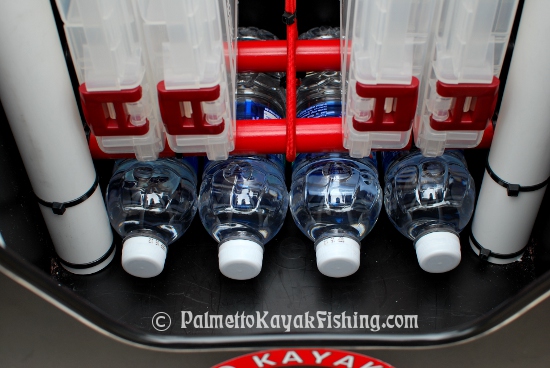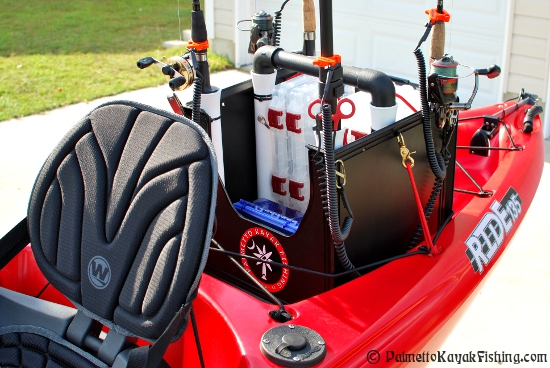Although I don't usually fish with live bait, it is hard to ignore the action that live herring can generate this time of year on Lake Murray when targeting stripers. On a handful of occasions I have used a simple Frabill aerator in combination with a small cooler to get the job done. The whole apparatus fits in the tankwell of my kayak, but this setup is far from ideal. The aerator is an inefficient power hog (remembering to purchase D batteries every trip gets old) and the durability is just not there. This may be satisfactory for one season of fishing with minnows, but I wanted something for the long haul that would do a better job of keeping the herring alive. In addition, an insulated container (i.e. cooler) is a must with the summer heat we have in SC.
Commercially available versions of kayak bait wells gave me sticker shock considering the key components include nothing more than a power source, a low volume bilge pump and a watertight container of some sort. Finish it off with a couple of rod holders and handles and there really isn’t much to it.
If you aren’t into the DIY stuff, then check out Hobie’s Kayak Live Well for around $300. Pick up an inexpensive waterproof Nano Spotter light from PKF’s online store and you can get the same lighting result as this DIY version. I give the designers at Hobie a thumbs up as the ergonomic design is quite nice. If you want to save over $200 though, keep reading.
Let me start by saying that this DIY bait well write up should serve as a general guide and that the principals and components used can be interchanged with a cooler or other parts you may already have on hand . If you decide to purchase the same Igloo cooler that I used in this build, all the measurements and parts listed below will match up with the pictures, minus the added light. I made everything removable so that I could use this cooler for other purposes.
Hardwiring the LED light was the most tedious task of this entire build. I knew it was going to be a pain soldering wires to the leads on the small circuit board that controls the LEDs. I chose to showcase what is possible if you wanted to take this project a little further. At the end of this build, I will teach you how to get the same lighting results without the headache and added cost of hardwiring the waterproof light.
Basic Parts List:
Standard Cooler (for this build, I chose Igloo’s 36 quartMarine Cooler - $22
6 Volt 10 AH Sealed Lead Acid Battery ($17.95 shipped from this Ebay Seller who stocks them regularly as of 9/2011)
Radio Shack’s Project Enclosure (7x5x3”) - $6.50
1 – Radio Shack Toggle Switch - $3.50 (Currently waiting on a delivery of 2 screw on rubber marine toggle covers, $2 Ebay)
Igloo 24011 Replacement Drain Plug - $4 (to pass wires through the cooler wall)
4 feet of marine bungee -$5
Hopkins 12 in. 2 pole flat set connector from Autozone $2 (part number: 47965)
1 - Nite Ize S biner, size 2 - $2
2 – suction cup wreath hangers $1.50 each (locally in the Columbia area at “Carolina Pottery”)
Large Zip Ties
Length of ½” Sched 40 PVC pipe, 2 – 90 degree PVC elbows, 1 – PVC cap, 1 – PVC threaded to slip adapter
2” long section of any ¾” inner diameter hose to make connection from bilge pump outlet to PVC threaded adaptor (see picture)
1 – NANO Spotter Light package WITHOUT base - $12.99 from PalmettoKayakFishing.com
Start by cutting the ½” PVC pipe to the following lengths:
A) 3 ¾“
B) 6 ½“
C) 16 ½“
Drill 5 holes in the long horizontal PVC pipe and assemble as pictured. I did not use PVC glue on these pieces as the friction holds them together just fine and makes breaking everything down for storage much easier. Firmly seat one end of the ¾“inner diameter hose onto the output of the bilge pump and the other end to the threaded section of the ½“ PVC adapter. Secure the hose in place with large zip ties.
Reposition the plastic wreath hooks to the suction cups as pictured. Press both suctions in place and slide the horizontal PVC tube in place – you will hear it “click” once it is properly seated on the suction cup clips.
The 6 volt SLA battery was chosen so that the force of the streams of water wouldn’t injure the baitfish. The bilge pump (rated for 500 GPH at 12 volts) now circulates 250 GPH with the 6 volt battery. This setup is more than enough to keep the herring happy and makes hardwiring the Nano Spotter light (also 6 volts) possible.
After drilling holes, installing the switches, running/soldering wires, sealing everything with Goop, etc., I wedged some scrap foam around the battery inside the box to keep it from moving. I used some left over “Duct Seal” to make a gasket to seal the plastic project box door once it was installed and screwed in place. This step ensures a watertight housing, yet allows the battery to be accessed if needed. Once the rubber marine toggle covers get delivered they will be installed to protect the switches from water damage. I have used it as pictured in fresh water with no issues so far, but think that this step is important for long term durability.
The black project box from Radio Shack comes with two rear doors - one is plastic and one is thin aluminum. Use a hacksaw or other tool to shape the aluminum plate as noted in the picture. Drill the proper sized holes in the thin aluminum sheet in order to mount it to the cooler using the existing screws. Bore out the two bottom holes large enough to pass the bungee cord through. I just knotted the ends of the bungee cord that pass through these holes.
Once the plate is installed, assemble and zip tie the two pieces of bungee cord as pictured and attach the S biner. This setup secures the battery box quite nicely. Use a hole saw drill bit to carefully bore a hole through the top corner of the cooler below the lid. Be sure to keep pressure on the opposite side of the cooler wall with a scrap piece of lumber so the bit actually cuts a hole instead of cracking the inside wall. (I drilled through the outside wall first, carefully cut away the foam on the inside, then reinserted the bit while pressing a block against the inner wall.)
Install the replacement drain and seal liberally with Goop. Now you have a nice, clean connection sleeve for the 2 pole flat connectors. When the cooler is not being used for bait, the drain cap can be screwed back on.
I charge the 6 volt SLA battery with this 6 volt charger from Walmart. Instead of taking the battery out of the sealed box, just attach the charger’s alligator clips to the proper +/- connections on the 2 pole connector and flip the toggle switch on the project box to the “on” position to open up the circuit.
In order to hard-wire the Nano Spotter, I cut the flashlight with a hacksaw as pictured. I then molded an end cap to fit securely over the exposed portion, drilled a hole in the cap and passed the wires through the flashlight body. Next, I carefully soldered the wires to the positive and negative leads on the circuit board of the light. A liberal amount of Goop was used to seal the end cap and the hole drilled for the wires. I reassembled the flashlight head and left it in the "on" position, allowing the additional toggle switch to control the on/off settings remotely. The rest is pretty self-explanatory – if you need an explanation on the basics of wiring up the connectors (w/o a switch) see the pictures on the Battery Box Blog Post HERE.
You can get the same lighting result by just using the Nano Spotter without modifying it. 4 AAA batteries deliver 60 hours of run time and the waterproof flashlight can be zip tied to any of the PVC parts, either under the waterline or above. A twist of the rubber flashlight head is all it takes to turn this light on and off. In fact, if you attach the supplied diffusion cone on the light, it will float and it can be turned on and just be tossed in the bait well. Whatever route you take, the light option makes it so easy to net the baitfish in low light conditions. The Nano Spotter packages include the 4 colored disks as pictured here to change the color output if desired.
 |
| Available at Palmetto Kayak Fishing's Online Store - Click HERE |
This bait well is solid and I have experienced great results from the battery. So far during the testing phase, I left both the battery and the light on for over 3 hours and it was still going strong. Herring also hold up quite well in there as I have noticed far fewer casualties compared to my previous setup. Lastly, I only fill the cooler up with water about a 1/3 of the way full which keeps the center of gravity of the bait well somewhat low in the back of my kayak. It is very manageable on the water and the light function is an much appreciated addition.
Enjoy! - Paul
Enjoy! - Paul

